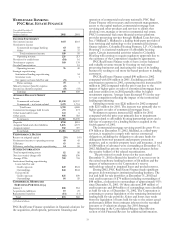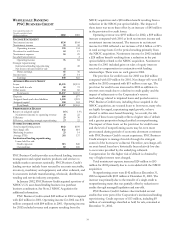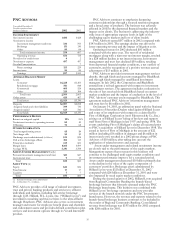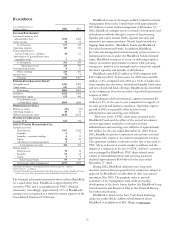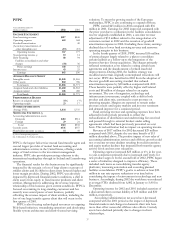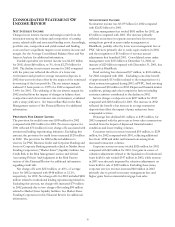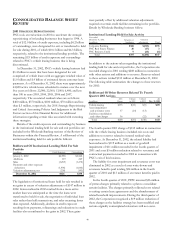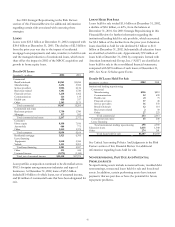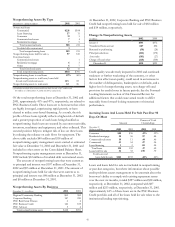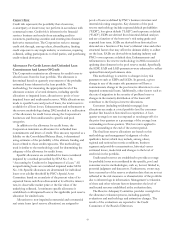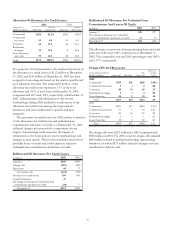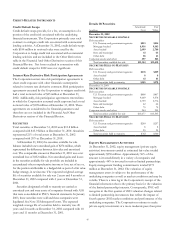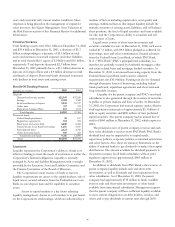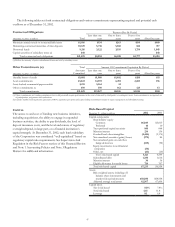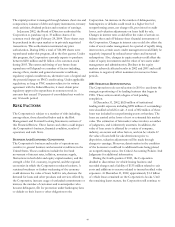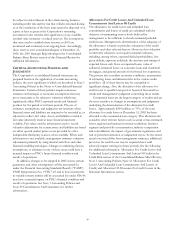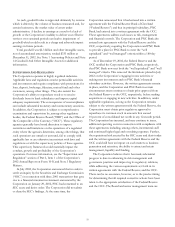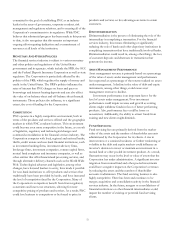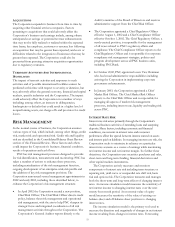PNC Bank 2002 Annual Report Download - page 45
Download and view the complete annual report
Please find page 45 of the 2002 PNC Bank annual report below. You can navigate through the pages in the report by either clicking on the pages listed below, or by using the keyword search tool below to find specific information within the annual report.43
CREDIT RISK
Credit risk represents the possibility that a borrower,
counterparty or insurer may not perform in accordance with
contractual terms. Credit risk is inherent in the financial
services business and results from extending credit to
customers, purchasing securities and entering into financial
derivative transactions. The Corporation seeks to manage
credit risk through, among others, diversification, limiting
credit exposure to any single industry or customer, requiring
collateral, selling participations to third parties, and purchasing
credit-related derivatives.
Allowances For Credit Losses And Unfunded Loan
Commitments And Letters Of Credit
The Corporation maintains an allowance for credit losses to
absorb losses from the loan portfolio. The allowance is
determined based on quarterly assessments of the probable
estimated losses inherent in the loan portfolio. The
methodology for measuring the appropriate level of the
allowance consists of several elements, including specific
allocations to impaired loans, allocations to pools of non-
impaired loans and unallocated reserves. While allocations are
made to specific loans and pools of loans, the total reserve is
available for all loan losses. Enhancements and refinements to
the reserve methodology during 2002 resulted in a reallocation
of the allowance for credit losses among the Corporation’s
businesses and from unallocated to specific and pool
categories.
In addition to the allowance for credit losses, the
Corporation maintains an allowance for unfunded loan
commitments and letters of credit. This amount, reported as a
liability on the Consolidated Balance Sheet, is determined
using estimates of the probability of the ultimate funding and
losses related to those credit exposures. The methodology
used is similar to the methodology used for determining the
adequacy of the allowance for credit losses.
Specific allowances are established for loans considered
impaired by a method prescribed by SFAS No. 114,
“Accounting by Creditors for Impairment of a Loan.” All
nonperforming loans are considered impaired under SFAS
No. 114. Specific allowances are determined for individual
loans over a dollar threshold by PNC’s Special Asset
Committee based on an analysis of the present value of its
expected future cash flows discounted at its effective interest
rate, its observable market price or the fair value of the
underlying collateral. A minimum specific allowance is
established on all impaired loans at the applicable pool reserve
allocation for similar loans.
Allocations to non-impaired commercial and commercial
real estate loans (pool reserve allocations) are assigned to
pools of loans as defined by PNC’s business structure and
internal risk rating categories. Key elements of the pool
reserve methodology include expected default probabilities
(“EDP”), loss given default (“LGD”) and exposure at default
(“EAD”). EDPs are derived from historical default analyses
and are a function of the borrower’s risk rating grade and
expected loan term. LGDs are derived from historical loss
data and are a function of the loan’s collateral value and other
structural factors that may affect the ultimate ability to collect
on the loan. EADs are derived from banking industry and
PNC’s own exposure at default data. Enhancements and
refinements to the reserve methodology in 2002 consisted of
updating data elements in the pool reserve model. Specifically,
the EDP, EAD and LGD parameters were enhanced to reflect
updated historical performance data.
This methodology is sensitive to changes in key risk
parameters such as EDPs and LGDs. In general, a given
change in any of the major risk parameters will have a
commensurate change in the pool reserve allocations to non-
impaired commercial loans. Additionally, other factors such as
the rate of migration in the severity of problem loans or
changes in the maturity distribution of the loans will
contribute to the final pool reserve allocations.
Consumer (including residential mortgage) loan
allocations are made at a total portfolio level by consumer
product line based on historical loss experience. A four-
quarter average loss rate is computed as net charge-offs for
the prior four quarters as a percentage of the average loan
outstandings in those quarters. This loss rate is applied to
loans outstanding at the end of the current period.
The final loan reserve allocations are based on this
methodology and management’s judgment of other
qualitative factors which may include, among others,
regional and national economic conditions, business
segment and portfolio concentrations, historical versus
estimated losses, model risk and changes to the level of
credit risk in the portfolio.
Unallocated reserves are established to provide coverage
for probable losses not considered in the specific, pool and
consumer reserve methodologies, such as, but not limited to,
potential judgment and data errors. Furthermore, events may
have occurred as of the reserve evaluation date that are not yet
reflected in the risk measures or characteristics of the portfolio
due to inherent lags in information. Management’s evaluation
of these and other relevant factors determines the level of
unallocated reserves established at the evaluation date.
The Reserve Adequacy Committee provides oversight for
the allowance evaluation process, including quarterly
evaluations and methodology and estimation changes. The
results of the evaluations are reported to the Credit
Committee of the Board of Directors.


